Physical Address
304 North Cardinal St.
Dorchester Center, MA 02124
Physical Address
304 North Cardinal St.
Dorchester Center, MA 02124
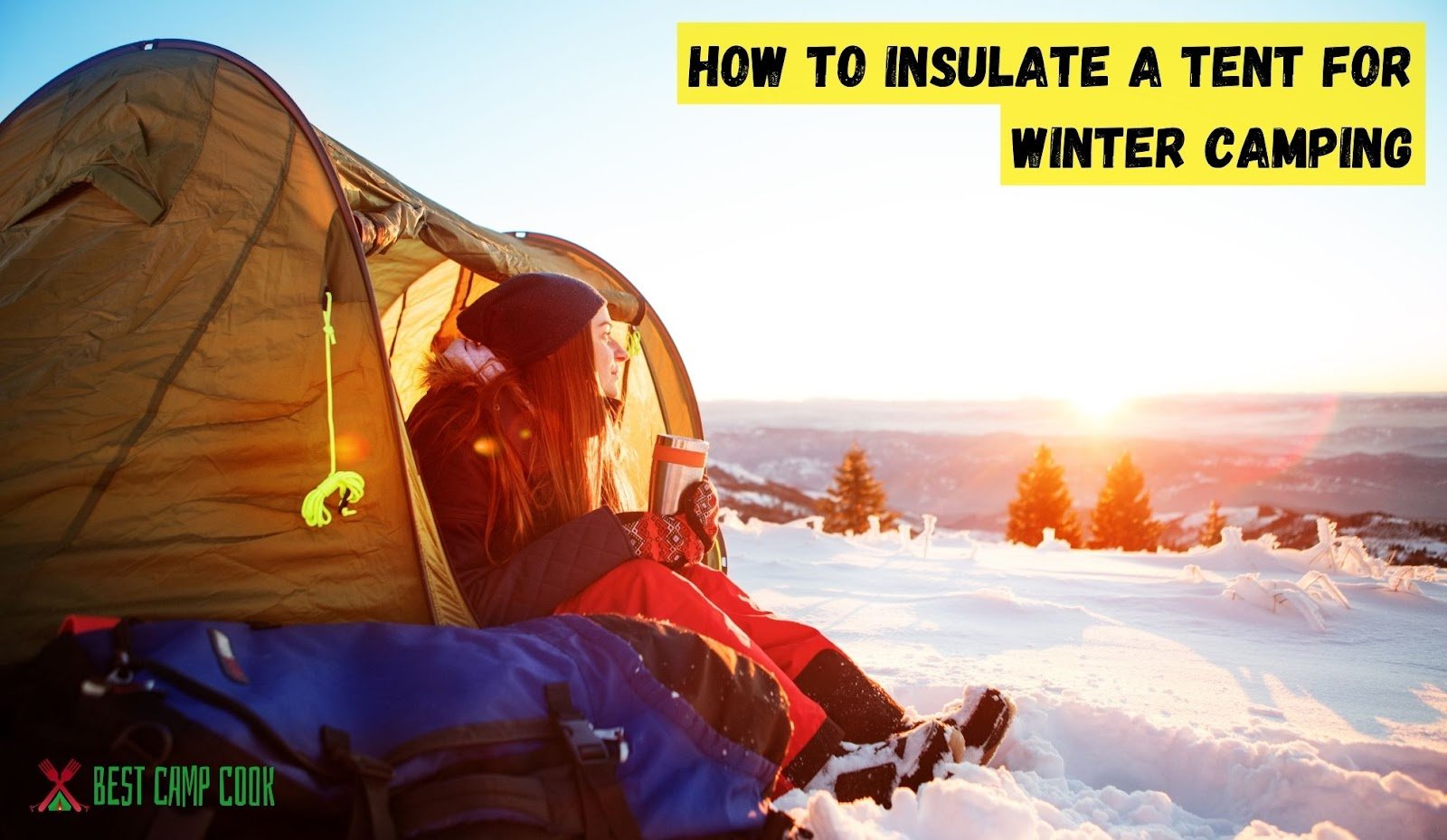
Discover the ultimate winter camping secret: How to insulate a tent for winter camping. Don’t let the cold weather dampen your outdoor adventures – instead, learn the art of creating a warm and cozy haven amidst the frosty wilderness.
Say goodbye to shivers and hello to snug nights under the starry sky. In this guide, we’ll unveil the expert tips and tricks to keep you warm and comfortable throughout your winter camping escapades.
Whether you’re a seasoned winter camper or a curious explorer venturing into the icy terrain for the first time, this concise yet informative introduction will ignite your curiosity and leave you eager to uncover the secrets of winter tent insulation.
So, grab your thermos of hot cocoa, bundle up, and let’s embark on an unforgettable journey to conquer the cold!
Main Summary: How to Insulate a Tent for Winter Camping?
To ensure warmth while winter camping use a four-season tent, add a foam pad or insulated mat, place a reflective blanket under the tent, seal gaps, and use a high-quality sleeping bag rated for cold temperatures. Stay cozy and protected during your winter outdoor adventures.
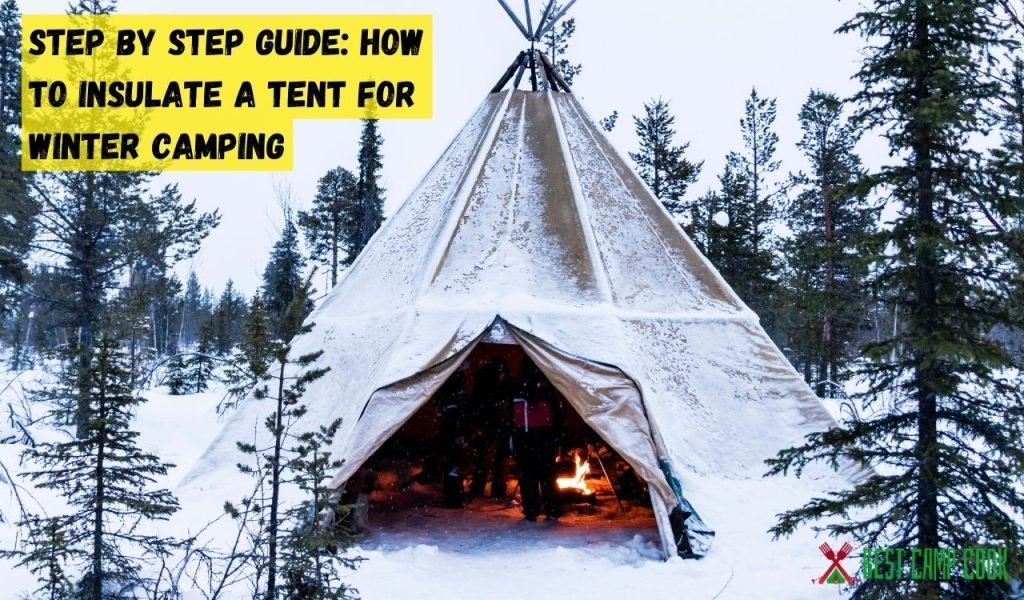
Selecting the perfect tent for winter camping is a critical decision that can significantly impact your comfort and safety in cold weather conditions. To ensure a successful winter camping experience, consider the following factors when choosing a tent:
Opt for a four-season or winter-specific tent designed to withstand harsh winter conditions. These tents are built with sturdier materials, stronger poles, and reinforced construction. They are designed to handle heavy snow loads, strong winds, and low temperatures, providing better protection and insulation.
Winter camping often involves setting up tents in cold and potentially adverse weather conditions. Look for tents that offer ease of setup, with color-coded poles and intuitive designs. Quick and hassle-free setup can save you valuable time and energy, preventing frustration and ensuring a smooth camping experience.
Tents with a geodesic or dome shape are ideal for winter camping. Their rounded design helps in shedding snow and wind, reducing the risk of collapse and improving stability. Additionally, look for tents with a rainfly that extends close to the ground to prevent drafts and snow from entering the tent.
While insulation is crucial in winter camping, proper ventilation is equally important. Look for tents with adjustable vents or mesh panels that allow for airflow and moisture management.
Adequate ventilation helps reduce condensation inside the tent, preventing dampness and frost buildup.
Consider the size and layout of the tent to ensure sufficient space for you and your gear. Winter camping often involves bulkier clothing and equipment, so a tent with extra headroom and storage pockets can be beneficial.
Additionally, a vestibule or porch area provides a convenient space for removing wet or muddy gear before entering the sleeping area.
Tents with snow skirts or snow flaps are designed to create a barrier between the tent and the ground, preventing snow from blowing in. These features are especially useful in snowy conditions. Additionally, having well-placed guy lines helps secure the tent, improving stability against high winds and heavy snow.
Consider the weight and packability of the tent, especially if you plan on backpacking or trekking to your camping destination. Look for lightweight materials and compact designs without compromising on durability and insulation.
It’s essential to strike a balance between weight and performance based on your specific needs and preferences.
When selecting a tent for winter camping, pay attention to the size and functionality of the vestibule area. A spacious vestibule can serve as a dedicated storage area for your winter gear, such as boots, snowshoes, and wet clothing.
It allows you to keep your gear separate from the sleeping area, ensuring a clean and organized living space inside the tent.
Before making a final decision, read user reviews and seek recommendations from experienced winter campers. Real-world experiences and feedback can provide valuable insights into the performance and reliability of different tent models in winter conditions.
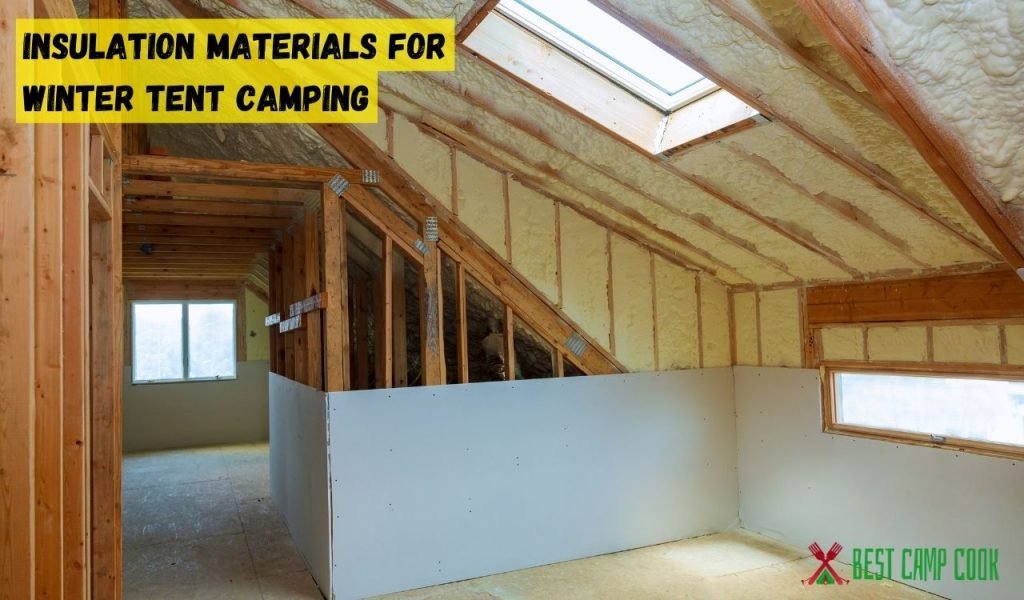
Proper insulation is crucial for staying warm and comfortable during winter tent camping. Understanding the different insulation materials available will help you make informed decisions when preparing your tent for cold weather conditions. Here are some key insulation materials to consider:
Synthetic insulation, such as polyester or nylon fibers, is a popular choice for winter camping. It offers excellent warmth even when wet, which is important in snowy and damp environments.
Synthetic insulation is also quick-drying and relatively affordable. Sleeping bags and insulated jackets with synthetic fill are readily available and provide reliable insulation in cold conditions.
Down insulation is known for its exceptional warmth-to-weight ratio, making it a preferred choice for many winter campers. It is made from the soft feathers found under the outer feathers of ducks or geese. Down insulation provides excellent loft and superior heat retention.
However, it loses its insulation properties when wet, so it’s essential to keep it dry during your camping trip. Down sleeping bags and jackets are highly effective in extremely cold temperatures but tend to be more expensive than synthetic options.
Closed-cell foam pads are commonly used as insulation layers beneath sleeping bags. These pads provide an additional barrier between you and the cold ground, preventing heat loss through conduction.
Closed-cell foam pads are lightweight, durable, and offer insulation even when compressed. They are an excellent choice for winter camping as they provide insulation and also act as a cushioned surface for sleeping.
Reflective insulation, often in the form of a metallicized film, helps retain body heat by reflecting it back to the camper. These insulating materials typically have a reflective surface on one or both sides, effectively minimizing heat loss through radiation.
Reflective insulation is lightweight, compact, and easy to incorporate into your camping setup. It is commonly used as an additional layer in sleeping pads, blankets, and emergency blankets.
Clothing plays a vital role in insulation during winter tent camping. Layering your clothing allows for better temperature regulation and insulation. Start with a moisture-wicking base layer to keep your skin dry, followed by an insulating mid-layer made of materials like fleece or wool.
Finally, add an outer shell layer that provides wind and water resistance. This layering system traps warm air close to your body while allowing moisture to escape.
Insulated tent footprints or ground cloths are waterproof and insulated layers placed between the tent floor and the ground. They provide an extra barrier against the cold ground, preventing heat loss through conduction.
Insulated tent footprints help maintain a warmer and more comfortable sleeping environment inside the tent.
Thermal blankets and tarps are versatile insulation options for winter camping. They can be used as additional layers inside the tent, hung as thermal curtains, or placed over the tent for added insulation.
These lightweight and compact materials reflect body heat and create a barrier against cold air, enhancing the overall insulation of your camping setup.
Wool is a natural insulation material that has excellent thermal properties, even when wet. It provides insulation by trapping warm air and regulating moisture, making it a reliable choice for winter camping.
Wool clothing, blankets, and sleeping bags offer warmth and comfort in cold conditions. Additionally, wool is naturally flame-resistant, making it a safer option for campfires and heating devices inside the tent.
Inflatable insulated sleeping pads combine the comfort of air mattresses with the insulation of closed-cell foam pads. These pads have chambers filled with insulating materials like synthetic fibers or down, providing warmth and cushioning.
Inflatable insulated sleeping pads offer excellent insulation from the cold ground and ensure a comfortable night’s sleep during winter camping trips.
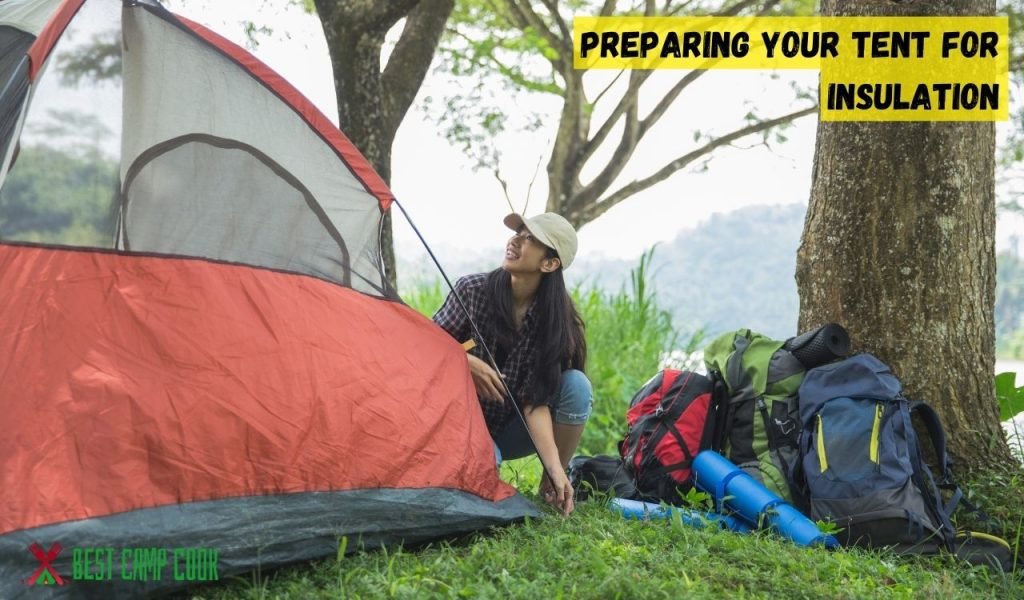
Properly preparing your tent for insulation is essential to create a warm and comfortable shelter during winter camping. Taking the necessary steps to maximize insulation will help keep cold air out and retain heat inside your tent. Here are some important considerations when preparing your tent for insulation:
Before adding insulation, ensure that your tent is clean and dry. Any moisture or dirt present on the tent’s surface can affect the effectiveness of insulation materials. Thoroughly clean the tent, paying attention to the floor, walls, and seams. Allow it to dry completely before proceeding with insulation.
Seam sealing is a process that ensures the tent’s seams are waterproof and airtight. Inspect the seams for any signs of wear or leakage, and apply seam sealer as needed.
This prevents cold air from seeping in and helps maintain a warmer interior. Seam sealing is particularly crucial for older or well-used tents that may have worn-out seams.
Using a tent footprint or groundsheet serves multiple purposes. It not only protects the tent floor from abrasion and moisture but also provides an additional layer of insulation against the cold ground.
Choose a footprint that is specifically designed for your tent model or cut one to fit the dimensions of your tent. Place it underneath the tent before setting it up.
Insulating the tent floor helps prevent heat loss through conduction. Use closed-cell foam pads or insulated sleeping pads to create a barrier between your sleeping area and the cold ground.
Lay the pads directly on the tent floor, ensuring they cover the entire sleeping area. This insulation layer will help keep you warm and comfortable throughout the night.
Windows and vents are common areas where cold air can enter the tent. Use insulating materials, such as thermal curtains or reflective blankets, to cover the windows from the inside.
This helps prevent drafts and minimizes heat loss. For vents, consider using vent covers or insulating them with removable insulation panels to maintain a warmer interior while still allowing proper ventilation.
Another effective way to insulate your tent is by hanging thermal curtains or blankets on the tent walls. This creates an additional layer of insulation and helps trap heat inside.
Secure the curtains or blankets using hooks, clips, or adhesive strips. Ensure they cover as much of the tent walls as possible for maximum insulation benefits.
Setting up a vestibule or windbreak outside your tent can significantly reduce exposure to cold winds. This additional sheltered area acts as a buffer zone, preventing direct wind contact with the tent walls.
Use a tarp or a separate tent fly to create a vestibule, or position your tent near natural windbreaks like trees or rocks. This minimizes heat loss and helps maintain a warmer interior.
Tent poles can conduct cold air into the tent, compromising insulation. Wrap the tent poles with insulating materials, such as foam pipe insulation or thick fabric, to create a barrier against heat transfer.
This simple step prevents the poles from becoming a source of cold air inside the tent.
If you frequently engage in winter camping, investing in a four-season tent designed for cold weather conditions is highly beneficial. These tents are specifically engineered to provide better insulation and withstand harsh elements.
They often feature stronger frames, reinforced materials, and enhanced ventilation systems that balance insulation and airflow.

Insulating the floor and walls of your tent is a crucial step in creating a warm and cozy environment for winter camping. It helps prevent heat loss and keeps cold air at bay. Here are some important considerations and techniques for effectively insulating your tent floor and walls:
One of the key areas to insulate is the tent floor. Place insulated ground mats or foam pads underneath your sleeping area to provide a barrier between you and the cold ground.
Closed-cell foam pads are particularly effective in preventing heat loss through conduction. Ensure the mats cover the entire sleeping area for maximum insulation benefits.
Layering your sleeping setup can provide additional insulation and warmth. Start with a thermal or insulated sleeping pad directly on the tent floor. On top of the pad, use a high-quality sleeping bag designed for cold weather camping.
Consider using a sleeping bag liner or quilt for added warmth. This layered approach creates a comfortable and well-insulated sleeping system.
To enhance insulation on the tent floor, use insulating blankets or sleeping bag covers. These can be placed underneath your sleeping bag or on top for extra warmth.
Opt for blankets or covers made from materials like fleece or thermal reflective fabric, as they provide excellent insulation properties. Secure them in place to prevent shifting during the night.
Insulating the tent walls helps maintain a comfortable temperature inside. Hang insulating wall layers such as thermal curtains, blankets, or reflective tarps. These materials create an additional barrier against cold air and help trap heat inside the tent.
Attach them securely to the walls using hooks, clips, or adhesive strips. Ensure they cover as much surface area as possible for optimal insulation.
Air pockets act as natural insulators by trapping warm air and preventing heat transfer. To create air pockets, leave a small gap between the insulating wall layers and the tent walls.
This space allows warm air to circulate and provides an extra layer of insulation. Be mindful not to leave large openings that may cause drafts or compromise the tent’s structural integrity.
Inspect the tent for any gaps, holes, or openings that may allow cold air to enter. Use duct tape or adhesive patches to seal these areas. Pay attention to the seams, zippers, windows, and vents.
Properly sealing gaps helps maintain the insulation integrity of the tent and prevents drafts.
Insulated tent liners are specially designed to enhance insulation in cold weather conditions. These liners attach to the inside of the tent, providing an additional layer of insulation throughout the entire structure.
They help reduce condensation, improve heat retention, and create a more comfortable camping experience in winter. Look for liners made from insulating materials like fleece or thermal fabrics.
Condensation can affect the effectiveness of insulation by making the tent damp and reducing its insulating properties. To minimize condensation, ensure proper ventilation by partially opening windows or vents.
Use moisture-wicking materials for bedding and clothing. Avoid cooking or boiling water inside the tent to prevent excess humidity. Proper airflow and moisture control contribute to a warmer and more comfortable camping environment.
Inspect your tent’s insulation before each camping trip to ensure it remains intact and effective. Check for any signs of wear, tears, or damage in the insulation layers. Repair or replace damaged materials promptly.
Additionally, maintain good tent hygiene by keeping the insulation clean and free from dirt or debris, as this can affect its insulating properties.
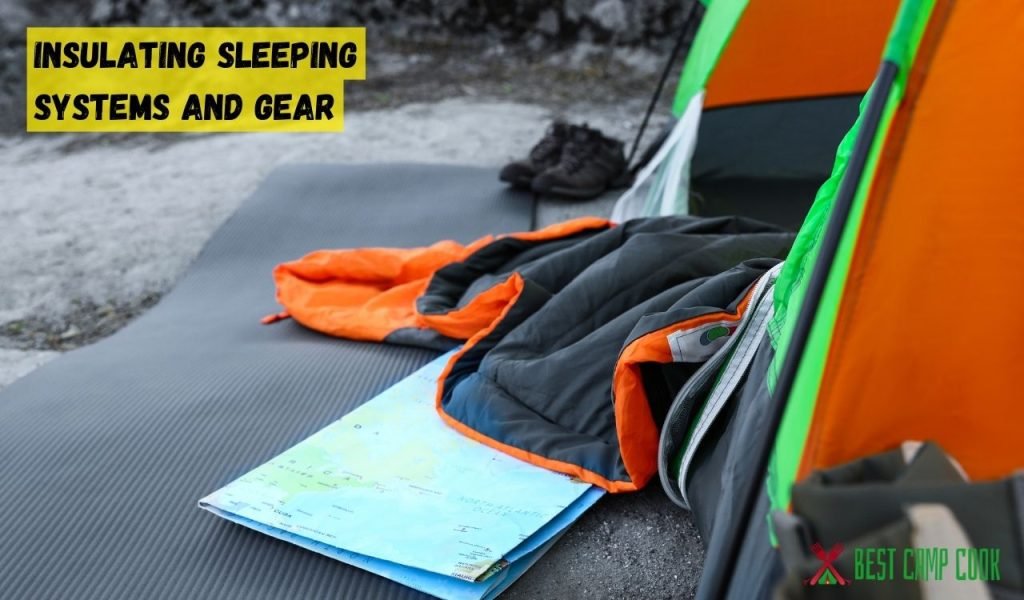
When it comes to winter camping, ensuring proper insulation for your sleeping system is essential for a comfortable and warm night’s sleep. Opt for sleeping bags or quilts that are specifically designed for cold temperatures.
Look for bags with high-quality insulation materials like down or synthetic fill, as they provide excellent warmth retention.
Additionally, consider the temperature rating of the sleeping bag or quilt to match the expected weather conditions.
Insulating your sleeping pad is crucial for minimizing heat loss through conduction. Choose a sleeping pad with a high R-value, which indicates its insulation capacity. For winter camping, opt for pads with R-values of 4 or higher to provide ample insulation from the cold ground.
Consider using double-layered sleeping pads or combining multiple pads for enhanced insulation. Foam or inflatable pads with built-in insulation are also effective options.
In addition to your sleeping system, insulating other gear items can further enhance your winter camping experience. Insulate your water bottles by using insulated covers or placing them in insulated sleeves to prevent freezing. This ensures that you have access to liquid water throughout your trip.
Insulating your electronics, such as cameras or phones, is also important. Store them in insulated pouches or pockets to protect them from the cold and maintain battery life.
An effective technique to add warmth to your sleeping system is by utilizing hot water bottles. Fill a sturdy, leak-proof bottle with hot water and place it inside your sleeping bag before bedtime.
This simple trick provides localized warmth and can significantly increase comfort during cold nights. Remember to use caution and ensure the bottle is properly sealed to prevent any accidents or leaks.
While insulation is crucial for staying warm during winter camping, it’s equally important to maintain proper ventilation inside your tent. Adequate ventilation helps to regulate moisture and prevent condensation buildup, which can make your sleeping environment damp and uncomfortable.
Most tents come with built-in ventilation options such as mesh panels or vents. Make sure to keep these openings clear and adjust them as needed to promote airflow without compromising insulation.
For an additional layer of insulation, consider using heat reflective blankets inside your sleeping system. These blankets are designed to reflect your body heat back towards you, increasing the overall warmth inside your sleeping bag or quilt.
Place the heat reflective blanket on top of your sleeping pad or underneath your sleeping bag to maximize its effectiveness. This simple yet effective technique can make a noticeable difference in keeping you warm throughout the night.
To minimize heat loss and cold drafts, properly seal any openings in your tent. Check for gaps around zippers, windows, and doors, and use weather-stripping or sealant to prevent air leakage. You can also use draft stoppers or door sweeps to seal the bottom edges of tent doors.
By eliminating these entry points for cold air, you’ll enhance the insulation of your tent and create a more comfortable and cozy camping environment.
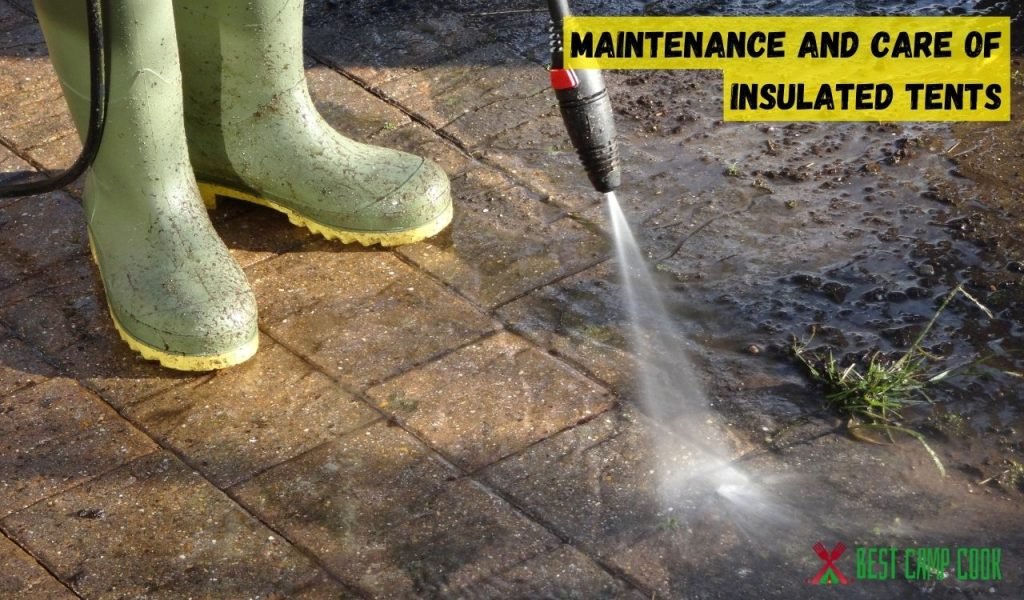
Proper maintenance and care of your insulated tent are crucial for its longevity and performance. Follow these tips to keep your tent in optimal condition:
Proper storage is essential to maintain the integrity of your insulated tent during the off-season. Consider the following guidelines:
Regularly inspecting your insulated tent for any signs of damage is important to address issues before they worsen. Here are some key areas to check:
Despite your best efforts, your insulated tent may occasionally sustain small tears or damage. Here’s how you can repair them effectively:
In addition to the tent itself, you may have various accessories and gear that require proper storage. Consider the following tips for storing your insulated tent accessories:
When embarking on a winter camping adventure, it’s crucial to prioritize safety to ensure a smooth and enjoyable experience. The cold weather and unique challenges of winter camping require careful planning and preparation. Here are some essential safety considerations to keep in mind:
Insulating your tent for winter camping goes beyond just the tent itself. Here are some additional tips to enhance insulation and maximize comfort during your winter camping adventure:
A tent footprint or groundsheet acts as a protective layer between your tent floor and the ground. It not only provides an extra barrier against moisture but also helps to insulate the tent floor.
Look for a groundsheet made of durable and waterproof material that fits the dimensions of your tent.
Reflective blankets or tarps can be used strategically to enhance insulation. Place them on the ground beneath your sleeping area to create an additional reflective layer that helps retain body heat. You can also use them to cover the outside of your tent for added insulation and to reflect heat back into the tent.
Tent poles can conduct cold temperatures into your tent. To minimize heat loss, consider insulating your tent poles. You can wrap them with foam or use insulating sleeves designed specifically for tent poles.
This simple step can make a noticeable difference in maintaining warmth inside the tent.
Inspect your tent for any gaps or drafts that can let cold air in and warm air out. Pay attention to areas such as zippers, seams, and windows. Use duct tape or seam sealer to seal any openings and prevent cold drafts from entering the tent. This will help maintain a comfortable and insulated environment inside.
Raising your sleeping area off the ground can provide additional insulation. Place a foam or air mattress beneath your sleeping bag to create a buffer between you and the cold ground. This helps to minimize heat loss and provides extra cushioning for improved comfort.
Hot water bottles or heat packs can be a cozy addition to your winter camping gear. Fill a water bottle with hot water before bed and place it inside your sleeping bag.
This can provide localized warmth and help keep you comfortable throughout the night. Heat packs can also be placed in your pockets or inside your sleeping bag for extra warmth.
Layering your sleep system involves using multiple layers of insulation to maximize warmth. Consider using a combination of a sleeping bag, sleeping bag liner, and blankets to create an effective barrier against the cold.
Layering allows you to adjust your insulation according to temperature fluctuations, ensuring you stay comfortable throughout the night.
While insulation is important, it’s equally crucial to maintain proper ventilation inside your tent. Condensation can occur when warm air meets a cold surface, leading to a damp and uncomfortable environment.
To prevent condensation buildup, open vents or crack open the tent door slightly to allow airflow. This helps to regulate moisture levels and prevent the accumulation of frost inside the tent.
Insulating your tent for winter camping is a vital step in ensuring a warm and comfortable experience in cold temperatures. By choosing the right tent, utilizing appropriate insulation materials, and properly preparing your tent for insulation, you can create a cozy sanctuary even in the harshest winter conditions.
Remember to consider factors such as tent size, weight, and durability when selecting a tent. Use insulation materials like foam pads, sleeping bag liners, and insulating blankets to provide additional warmth. Take the time to properly prepare your tent by sealing gaps, insulating tent poles, and elevating your sleeping area.
Finally, prioritize safety considerations and be prepared for the unique challenges winter camping presents. With these tips and careful planning, you’ll be well-equipped to enjoy winter camping adventures while staying warm, comfortable, and safe.
Insulating a tent for winter camping is crucial because it helps retain heat inside the tent, keeping you warm and comfortable in cold temperatures. Proper insulation prevents heat loss, reduces condensation, and creates a barrier against the cold outside air.
While any tent can be used for winter camping, it’s recommended to choose a four-season or winter-specific tent. These tents are designed with stronger materials, additional poles for stability, and features like snow skirts and reinforced zippers to withstand harsh winter conditions.
Commonly used insulation materials for tents include foam pads, insulating blankets, and sleeping bag liners. Foam pads provide insulation between the cold ground and your sleeping bag, while insulating blankets and liners add an extra layer of warmth inside the tent.
To insulate the tent floor, place a foam pad or an insulating blanket beneath your sleeping area. This provides a barrier against the cold ground, preventing heat loss and adding cushioning for comfort.
Insulating the tent walls can further enhance warmth inside the tent. You can use insulating blankets or reflective materials to line the walls. Additionally, sealing any gaps or drafts in the tent walls helps minimize heat loss and cold air infiltration.
In extreme cold conditions, consider using multiple layers of insulation, such as combining a high-quality sleeping bag with a sleeping bag liner and insulating blankets. Elevating your sleeping area off the ground, sealing all openings, and insulating tent poles also contribute to better insulation in extreme cold.
It is generally not recommended to use heaters inside tents due to safety risks. Instead, focus on proper insulation techniques, using suitable insulation materials, and layering your sleep system for warmth.
If you choose to use a heater, make sure it is specifically designed for tent use and follow all safety guidelines.
To minimize condensation, ensure proper ventilation by opening vents or slightly cracking the tent door to allow airflow. This helps regulate moisture levels and reduces the chances of condensation buildup.
Yes, safety is paramount during winter camping. Some key considerations include checking weather forecasts, informing others about your camping plans, carrying essential survival gear, dressing in appropriate clothing layers, and being aware of potential hazards like avalanches or falling icicles.
Absolutely! There are cost-effective ways to insulate a tent for winter camping. For example, using blankets or reflective tarps, repurposing old sleeping bags as additional layers, or improvising with materials like bubble wrap can provide insulation without breaking the bank.